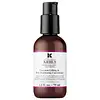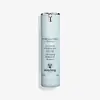What's inside
What's inside
 Key Ingredients
Key Ingredients

 Benefits
Benefits

 Concerns
Concerns

 Ingredients Side-by-side
Ingredients Side-by-side

Water
Skin ConditioningButylene Glycol
HumectantBis-PEG-18 Methyl Ether Dimethyl Silane
EmollientMethyl Gluceth-20
HumectantPEG-20
HumectantSqualane
EmollientDimethicone
EmollientAlcohol Denat.
AntimicrobialOctyldodecanol
EmollientCyclohexasiloxane
EmollientLauroyl Lysine
Skin ConditioningCarbomer
Emulsion StabilisingPhenoxyethanol
PreservativeTocopheryl Acetate
AntioxidantHydrogenated Lecithin
EmulsifyingPentylene Glycol
Skin ConditioningCaprylyl Glycol
EmollientPolysilicone-11
Yeast Extract
Skin ConditioningXanthan Gum
EmulsifyingAcrylates/C10-30 Alkyl Acrylate Crosspolymer
Emulsion StabilisingPvp
Emulsion StabilisingPelargonium Graveolens Flower Oil
MaskingAdenosine
Skin ConditioningCapryloyl Salicylic Acid
ExfoliatingDisodium EDTA
Sodium Hydroxide
BufferingGlycine Max Seed Extract
Skin ConditioningCitronellol
PerfumingGeraniol
PerfumingRosmarinus Officinalis Leaf Oil
MaskingLinalool
PerfumingCitral
PerfumingLimonene
PerfumingWater, Butylene Glycol, Bis-PEG-18 Methyl Ether Dimethyl Silane, Methyl Gluceth-20, PEG-20, Squalane, Dimethicone, Alcohol Denat., Octyldodecanol, Cyclohexasiloxane, Lauroyl Lysine, Carbomer, Phenoxyethanol, Tocopheryl Acetate, Hydrogenated Lecithin, Pentylene Glycol, Caprylyl Glycol, Polysilicone-11, Yeast Extract, Xanthan Gum, Acrylates/C10-30 Alkyl Acrylate Crosspolymer, Pvp, Pelargonium Graveolens Flower Oil, Adenosine, Capryloyl Salicylic Acid, Disodium EDTA, Sodium Hydroxide, Glycine Max Seed Extract, Citronellol, Geraniol, Rosmarinus Officinalis Leaf Oil, Linalool, Citral, Limonene
Water
Skin ConditioningGlycerin
HumectantButylene Glycol
HumectantDimethicone
EmollientIsodecyl Neopentanoate
EmollientAlcohol Denat.
AntimicrobialPolyacrylate Crosspolymer-6
Emulsion StabilisingSaccharide Isomerate
HumectantPanthenol
Skin ConditioningTocopheryl Acetate
AntioxidantLeontopodium Alpinum Flower/Leaf Extract
Skin ConditioningMentha Aquatica Leaf Extract
Skin ConditioningIris Florentina Root Extract
MaskingYeast Extract
Skin ConditioningMalachite Extract
AntioxidantAdenosine
Skin ConditioningViola Tricolor Extract
EmollientCryptomeria Japonica Bud Extract
Skin ConditioningCeratonia Siliqua Seed Extract
Skin ConditioningLavandula Angustifolia Oil
MaskingThymus Mastichina Flower Oil
Skin ConditioningSalvia Officinalis Oil
MaskingHydroxyethyl Acrylate/Sodium Acryloyldimethyl Taurate Copolymer
Emulsion StabilisingXanthan Gum
EmulsifyingDisodium EDTA
Citric Acid
BufferingPolysorbate 60
EmulsifyingSorbitan Isostearate
EmulsifyingEthylhexylglycerin
Skin ConditioningSodium Citrate
BufferingSodium Hydroxide
BufferingPhenoxyethanol
PreservativeSodium Benzoate
MaskingLinalool
PerfumingLimonene
PerfumingGeraniol
PerfumingWater, Glycerin, Butylene Glycol, Dimethicone, Isodecyl Neopentanoate, Alcohol Denat., Polyacrylate Crosspolymer-6, Saccharide Isomerate, Panthenol, Tocopheryl Acetate, Leontopodium Alpinum Flower/Leaf Extract, Mentha Aquatica Leaf Extract, Iris Florentina Root Extract, Yeast Extract, Malachite Extract, Adenosine, Viola Tricolor Extract, Cryptomeria Japonica Bud Extract, Ceratonia Siliqua Seed Extract, Lavandula Angustifolia Oil, Thymus Mastichina Flower Oil, Salvia Officinalis Oil, Hydroxyethyl Acrylate/Sodium Acryloyldimethyl Taurate Copolymer, Xanthan Gum, Disodium EDTA, Citric Acid, Polysorbate 60, Sorbitan Isostearate, Ethylhexylglycerin, Sodium Citrate, Sodium Hydroxide, Phenoxyethanol, Sodium Benzoate, Linalool, Limonene, Geraniol
Ingredients Explained
These ingredients are found in both products.
Ingredients higher up in an ingredient list are typically present in a larger amount.
Adenosine is in every living organism. It is one of four components in nucleic acids that helps store our DNA.
Adenosine has many benefits when used. These benefits include hydrating the skin, smoothing skin, and reducing wrinkles. Once applied, adenosine increases collagen production. It also helps with improving firmness and tissue repair.
Studies have found adenosine may also help with wound healing.
In skincare products, Adenosine is usually derived from yeast.
Learn more about AdenosineAlcohol Denat. is an alcohol with a denaturant property. It is created by mixing ethanol with other additives.
This ingredient gets a bad rep because it is irritating and drying - mostly due to its astringent property. Astringents draw out natural oils in tissue, constricting pores and leaving your skin dried out.
However, alcohol denat. is not all that bad.
Due to its low molecular weight, alcohol denat. tends to evaporate quickly. One study on pig skin found half of applied alcohol evaporated in 10 seconds and less than 3% stayed on skin.
This also helps other ingredients become better absorbed upon application.
Studies are conflicted about whether this ingredient causes skin dehydration. One study from 2005 found adding emollients to propanol-based sanitizer decreased skin dryness and irritation. Another study found irritation only occurs if your skin is already damaged.
Small amounts of alcohol are generally tolerated by oily skin or people who live in humid environments.
The rule of thumb is if this alcohol is near the end of an ingredients list, it will probably not affect your skin much.
Also...
This ingredient has antimicrobial and solvent properties.
The antimicrobial property helps preserve products and increase their shelf life. As a solvent, it helps dissolve other ingredients.
Other types of astringent alcohols include:
Learn more about Alcohol Denat.Butylene Glycol (or BG) is used within cosmetic products for a few different reasons:
Overall, Butylene Glycol is a safe and well-rounded ingredient that works well with other ingredients.
Though this ingredient works well with most skin types, some people with sensitive skin may experience a reaction such as allergic rashes, closed comedones, or itchiness.
Learn more about Butylene GlycolDimethicone is a type of synthetic silicone created from natural materials such as quartz.
What it does:
Dimethicone comes in different viscosities:
Depending on the viscosity, dimethicone has different properties.
Ingredients lists don't always show which type is used, so we recommend reaching out to the brand if you have questions about the viscosity.
This ingredient is unlikely to cause irritation because it does not get absorbed into skin. However, people with silicone allergies should be careful about using this ingredient.
Note: Dimethicone may contribute to pilling. This is because it is not oil or water soluble, so pilling may occur when layered with products. When mixed with heavy oils in a formula, the outcome is also quite greasy.
Learn more about DimethiconeDisodium EDTA plays a role in making products more stable by aiding other preservatives.
It is a chelating agent, meaning it neutralizes metal ions that may be found in a product.
Disodium EDTA is a salt of edetic acid and is found to be safe in cosmetic ingredients.
Learn more about Disodium EDTAGeraniol is used to add fragrance/parfum to a product. It is the main component of citronellol. It is a monoterpenoid and an alcohol.
Monoterpenes are naturally found in many parts of different plants.
Geraniol can be found in many essential oils including Rose Oil and Citronella Oil. The scent of Geraniol is often described as "rose-like". Many foods also contain Geraniol for fruit flavoring.
Geraniol can irritate the skin when exposed to air. However, irritation depends on the ability of geraniol to penetrate into the skin. In general, geraniol is not able to penetrate skin easily.
Geraniol is colorless and has low water-solubility. However, it is soluble in common organic solvents.
Like citronellol, it is a natural insect repellent.
2,6-Octadien-1-ol, 3,7-dimethyl-, (2E)-
Learn more about GeraniolLimonene is a fragrance that adds scent and taste to a formulation.
It's found in the peel oil of citrus fruits and other plants such as lavender and eucalyptus. The scent of limonene is generally described as "sweet citrus".
Limonene acts as an antioxidant, meaning it helps neutralize free radicals.
When exposed to air, oxidized limonene may sensitize the skin. Because of this, limonene is often avoided by people with sensitive skin.
The term 'fragrance' is not regulated in many countries. In many cases, it is up to the brand to define this term. For instance, many brands choose to label themselves as "fragrance-free" because they are not using synthetic fragrances. However, their products may still contain ingredients such as essential oils that are considered a fragrance.
Learn more about LimoneneLinalool is a fragrance and helps add scent to products. It's derived from common plants such as cinnamon, mint, citrus, and lavender.
Like Limonene, this ingredient oxidizes when exposed to air. Oxidized linalool can cause allergies and skin sensitivity.
This ingredient has a scent that is floral, spicy tropical, and citrus-like.
Learn more about LinaloolPhenoxyethanol is a preservative that has germicide, antimicrobial, and aromatic properties. Studies show that phenoxyethanol can prevent microbial growth. By itself, it has a scent that is similar to that of a rose.
It's often used in formulations along with Caprylyl Glycol to preserve the shelf life of products.
Sodium Hydroxide is also known as lye or caustic soda. It is used to adjust the pH of products; many ingredients require a specific pH to be effective.
In small amounts, sodium hydroxide is considered safe to use. However, large amounts may cause chemical burns due to its high alkaline.
Your skin has a natural pH and acid mantle. This acid mantle helps prevent harmful bacteria from breaking through. The acid mantle also helps keep your skin hydrated.
"Alkaline" refers to a high pH level. A low pH level would be considered acidic.
Learn more about Sodium HydroxideTocopheryl Acetate is AKA Vitamin E. It is an antioxidant and protects your skin from free radicals. Free radicals damage the skin by breaking down collagen.
One study found using Tocopheryl Acetate with Vitamin C decreased the number of sunburned cells.
Tocopheryl Acetate is commonly found in both skincare and dietary supplements.
Learn more about Tocopheryl AcetateWater. It's the most common cosmetic ingredient of all. You'll usually see it at the top of ingredient lists, meaning that it makes up the largest part of the product.
So why is it so popular? Water most often acts as a solvent - this means that it helps dissolve other ingredients into the formulation.
You'll also recognize water as that liquid we all need to stay alive. If you see this, drink a glass of water. Stay hydrated!
Learn more about WaterXanthan gum is used as a stabilizer and thickener within cosmetic products. It helps give products a sticky, thick feeling - preventing them from being too runny.
On the technical side of things, xanthan gum is a polysaccharide - a combination consisting of multiple sugar molecules bonded together.
Xanthan gum is a pretty common and great ingredient. It is a natural, non-toxic, non-irritating ingredient that is also commonly used in food products.
Learn more about Xanthan GumYeast extract is a silky, clear liquid derived from yeast (usually Saccharomyces cerevisiae or Torula yeast).
This ingredient has plenty of skin benefits:
Bioferments of yeast and soy have been found to reduce hyperpigmentation at low levels.
Due to its fatty acid content, this ingredient may not be fungal-acne safe.
Learn more about Yeast Extract